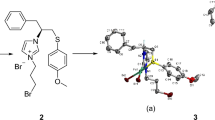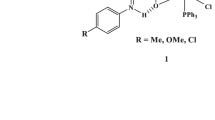Abstract
Vanadium (V) catalyzes perborate oxidation of substituted 5-oxo acid in acidic solution, being 1.6 order with respect to the oxidant, first order in the catalyst, inhibited by H+ and displays Michaelis–Menten kinetics on the reductant. In aqueous acetic acid solution, perborate generates hydrogen peroxide and the kinetic results reveal formation of oxodiperoxovanadium(V)-oxo acid complex. At high acidity, the ionic strength of the medium has little influence on the oxidation rates. But at low acidity, the rate increases with increasing ionic strength. The rate of oxidation increases with decreasing dielectric constant of the medium. Electron-releasing substituents in the aromatic ring accelerate the reaction rate and electron-withdrawing substituents retard the reaction. The order of reactivity among the studied 5-oxo acid is p-methoxy >> p-methyl > p-phenyl > -H > p-chloro > p-bromo > m-nitro. Activation parameters have been evaluated using Arrhenius and Eyring’s plots. A mechanism consistent with the observed kinetic data has been proposed and discussed. A suitable rate law has been derived based on the mechanism.





Similar content being viewed by others
References
Karunakaran C, Muthukumaran B (1999) Vanadium(V) catalysis of perborate oxidation of iodide ion. Pol J Chem 73:1827–1836
Connor TM, Richards RE (1958) J. Chem. Soc. 289–293.
Edwards JO, Ross VF (1967) The structural chemistry of the borates. In: Muetterties EL (ed) The chemistry of boron and its compounds. Wiley, New York, p 192
Cotton FA, Wilkinson G (1988) Advanced inorganic chemistry, 5th edn. Wiley Interscience, NY, p 172
McKillop A, Sanderson WR (1995) Organic chemistry portal. Tetrahedron 51:6145–6166
McKillop A, Sanderson WR (2000) Sodium perborate and sodium percarbonate: further applications in organic synthesis. J Chem Soc Perkin Trans 1:471–479
Muzart J (1995) Organic chemistry portal. Synthesis 1325–1347
Karunakaran C, Palanisamy PN (1998) Kinetic evidence for (N,N-dimethylaniline)-oxodiperoxomolybdenum(VI) or tungsten(VI) as oxidizing species in molybdenum(VI) or tungsten(VI) catalyzed hydrogen peroxide (perborate) oxidation of N,N-dimethylaniline. Synth React Inorg Met-Org Chem 28:1115–1125
Karunakaran C, Muthukumaran B (1997) Zirconium (IV) catalysis in perborate oxidation of iodide. React Kinet Catal Lett 60:387–394
Karunakaran C, Muthukumaran B (1995) Molybdenum(VI) catalysis of perborate or hydrogen peroxide oxidation of iodide ion. Transition Met Chem 20:460–462
Karunakaran C, Manimekalai P (1991) Kinetics and mechanism of perborate oxidation of organic sulphides. Tetrahedron 47:8733–8738
Karunakaran C, Kamalam R (2000) On the mechanism of the perborate oxidation of organic sulfides in glacial acetic acid. Eur J Org Chem 3261. doi:10.1002/1099-0690(200010)
Karunakaran C, Ramachandran V, Palanisamy PN (1999) Linear free energy relationship in complex reaction: tungsten(VI) catalyzed perborate oxidation of S-phenylmercaptoacetic acids. Int J Chem Kinet 31:675–681
Karunakaran C, Kamalam R (2002) Mechanism and reactivity in perborate oxidation of anilines in acetic acid. J Chem Soc Perkin Trans 2:2011–2018
Kungumathilagam D, Karunakaran K (2013) Kinetics and mechanism of meso-tetraphenylporphyriniron(III) chloride (TPP) catalyzed oxidation of indole by sodium perborate. Pol J Chem Tech 15(2):107–111
Marigangaiah NP, Banerji KK (1976) Indian J Chem 14A:660
Meenakshi A, Santhappa M (1973) Indian J Chem 11:393
Mohamed Farook NA (2007) Kinetics of oxidation of 4-oxoacids by N-chlorosaccharin in aqueous acetic acid medium. J Solut Chem 36:345–356
Mohamed Farook NA, Seyed Dameem GA (2011) Kinetics of oxidation of 3-benzoylpropionic acid by N-chlorobenzamide in aqueous acetic acid medium. J Chem 8:561–564. doi:10.1155/2011/697973
Freeda Gnana Rani D, Maria Pushparaj FJ, Alphonse I, Rangappa KS (2002) Kinetics and mechanism of oxidation of 4-oxoacids by hexacyanoferrate(III) catalysed by Os(VIII). Indian J Chem 41B:2153–2159
Sikkandar G (2000) Asian J Chem 12:1037–1040
Kenneth B, Wiberg K, Stewart R (1955) J Am Chem Soc 77:1983–1986
Vogel AI (1958) Text book of quantitative chemical analysis, 5th edn. Longman, New York, pp 708–720
Tompkins FC (1943) Trans Faraday Soc 39:267–280
Duke FR (1952) J Phys Chem 56:882
Alder MG, Leffler JE (1954) J Am Chem Soc 76:1425–1427
Feigl F, Anger V (1975) Spot tests in organic analysis. Elsevier, Amsterdam, p 459
Linert W (1994) Chem Soc Rev 23:429
Linert W, Jameson RF (1989) The isokinetic relationship. Chem Soc Rev 18:477–505
Shorter J, Zalewski RI, Krygowski TM (1991) Similarity models in organic chemistry. In: Shorter J (ed) Biochemistry and related fields. Elsevier, Amsterdam, p 80
Dayal SK, Ehrenson S, Taft RW (1972) Substituent effects, electronic transmission, and structural dependence of .pi. Delocalization as studied with the p-fluorophenyl tag. J Am Chem Soc 94:9113–9122
Pizer R, Tihal C (1987) Inorg Chem 26:3639–3642
Folder entitled “The chemistry of vanadium” on your bench
Cotton FA, Wilkinson G Basic inorganic chemistry, Sections 24.9–24.12
Huheey JE Inorganic chemistry, 3rd edn. Appendix F
Shriver DF, Atkins PW, Langford CH (1990) Inorganic chemistry, chapter 8
Bradley DC, Thornton P (1973) In: Bailar JC et al (eds) Comprehensive inorganic chemistry, vol 3. Oxford, Pergamon
Connor JA, Ebsworth EAV (1964) In: Emeleus HJ, Sharpe AG (eds) Advances in inorganic chemistry and radiochemistry, vol 6. Academic, NY, p 279
Orhanovic M, Wilkins RG (1967) J Am Chem Soc 89:278
Ogata Y, Tanaka K (1982) Kinetics of the oxidation of diphenyl sulfide with hydrogen peroxide catalyzed by sodium metavanadate. Can J Chem 60:848–852. doi:10.1139/v82-128
Author information
Authors and Affiliations
Corresponding author
Rights and permissions
About this article
Cite this article
Shree Devi, S., Muthukumaran, B. & Krishnamoorthy, P. Vanadium(V) catalysis of perborate oxidation of substituted 5-oxo acids: a kinetic and mechanistic study. Ionics 20, 1783–1794 (2014). https://doi.org/10.1007/s11581-014-1135-y
Received:
Revised:
Accepted:
Published:
Issue Date:
DOI: https://doi.org/10.1007/s11581-014-1135-y




